| Morrison Formation | |
|---|---|
| Stratigraphic range: Upper Jurassic (Kimmeridgian to Tithonian), | |
 The distinctive banding of the Morrison Formation, a group of rock layers that occur throughout Dinosaur National Monument and the source of fossils like those found at the Dinosaur Quarry | |
| Type | Geologic formation |
| Underlies | Cedar Mountain Formation, Cloverly Formation, Lakota Formation, Burro Canyon Formation |
| Overlies | Summerville Formation, Beclabito Formation, Curtis Formation, Bell Ranch Formation, Sundance Formation |
| Thickness | Up to 200 m |
| Lithology | |
| Primary | Mudstone |
| Other | Sandstone, siltstone, limestone |
| Location | |
| Coordinates | 39°39′04″N 105°11′17″W / 39.651°N 105.188°W |
| Region | Central North America: |
| Country | |
| Extent |  Stratotypes for members of the Morrison Formation |
| Type section | |
| Named for | Morrison, Colorado |

The Morrison Formation is a distinctive sequence of Upper Jurassic sedimentary rock found in the western United States which has been the most fertile source of dinosaur fossils in North America. It is composed of mudstone, sandstone, siltstone, and limestone and is light gray, greenish gray, or red. Most of the fossils occur in the green siltstone beds and lower sandstones, relics of the rivers and floodplains of the Jurassic period.
It is centered in Wyoming and Colorado, with outcrops in Montana, North Dakota, South Dakota, Nebraska, Kansas, the panhandles of Oklahoma and Texas, New Mexico, Arizona, Utah, and Idaho. Equivalent rocks under different names are found in Canada.[2] It covers an area of 1.5 million square kilometers (600,000 square miles), although only a tiny fraction is exposed and accessible to geologists and paleontologists. Over 75% is still buried under the prairie to the east, and much of its western paleogeographic extent was eroded during exhumation of the Rocky Mountains.
It was named after Morrison, Colorado, where some of the first fossils in the formation were discovered by Arthur Lakes in 1877. That same year, it became the center of the Bone Wars, a fossil-collecting rivalry between early paleontologists Othniel Charles Marsh and Edward Drinker Cope. In Colorado, New Mexico, and Utah, the Morrison Formation was a major source of uranium ore.
Geologic history
According to radiometric dating, the Morrison Formation dates from 156.3 ± 2 million years old (Ma) at its base,[3] to 146.8 ± 1 million years old at the top,[4] which places it in the earliest Kimmeridgian, and early Tithonian stages of the late Jurassic. This is similar in age to the Solnhofen Limestone Formation in Germany and the Tendaguru Formation in Tanzania. The age and much of the fauna is similar to the Lourinhã Formation in Portugal.[5] Throughout the western United States, it variously overlies the Middle Jurassic Summerville, Sundance, Bell Ranch, Wanakah, and Stump Formations.
At the time, the supercontinent of Laurasia had recently split into the continents of North America and Eurasia, although they were still connected by land bridges. North America moved north and was passing through the subtropical regions.
The Morrison Basin, which stretched from New Mexico in the south to Alberta and Saskatchewan in the north, was formed during the Nevadan orogeny, a precursor event to later orogenic episodes that created the Rocky Mountains started pushing up to the west. The deposits from their east-facing drainage basins, carried by streams and rivers from the Elko Highlands (along the borders of present-day Nevada and Utah) and deposited in swampy lowlands, lakes, river channels and floodplains, became the Morrison Formation.[6]
In the north, the Sundance Sea, an extension of the Arctic Ocean, stretched through Canada down to the United States. Coal is found in the Morrison Formation of Montana, which means that the northern part of the formation, along the shores of the sea, was wet and swampy, with more vegetation. Aeolian, or wind-deposited sandstones, are found in the southwestern part, which indicates it was much more arid—a desert, with sand dunes.
Stratigraphy


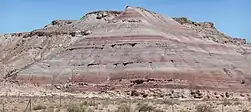
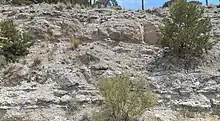
The Morrison Formation is subdivided into several members, the occurrence of which are varied across the geographic extent of the Morrison. Members are (in alphabetical order):[7][8]
- Bluff Sandstone Member (AZ, CO, NM, UT): Well-sorted, light brown to white sandstone with large grains and components of chert. Interpreted as being deposited in an aeolian setting, at the edge of a dune field.[9]
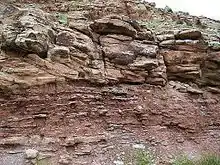
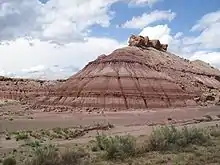
- Brushy Basin Member (AZ, CO, NM, UT): conglomerate interbedded with mudstone; up to fifty percent by volume is made up of altered vitric ash, which originated as felsic ash falls. Deposition likely occurred in a fluvial-lacustrine environment, with the lacustrine component tending towards playas.[10]
- Fiftymile Member (UT): Mainly present in the Kaiparowits basin, consisting of interbedded sandstone and mudstone, with minimal conglomerate. Locally, it is the uppermost member and has contact with the Dakota Formation.[11]
- Jackpile Sandstone Member (NM): primarily a whitish crossbedded subarkose sandstone with a clay matrix. It is interbedded with variegated, pale-green to red, bentonitic mudstone lenses.[12] However, recent detrital zircon geochronology results have suggested that the Jackpile Sandstone Member is part of the Burro Canyon Formation.[13][14]
- Ralston Creek Member (CO): formerly a considered separate formation and recently reclassified as the basal member of the Morrison in eastern Colorado. It appears analogous to the Tidwell and Salt Wash Members. This reclassification is supported by more detailed examination of the contacts and radiometric dating. The Ralston Creek contains conglomerate, sandstone, gypsum-mudstone, and gypsum-sandstone-mudstone facies; it is undetermined if the gypsum is of marine or lacustrine origin.[15]
- Recapture Member (AZ, CO, NM, UT): forms the bottom of the Morrison across most of its range, overlying the Entrada and Wanakah Formations.[16] Consists of clayey sandstone and claystone, representing a fluvial setting, interbedded with purely aeolian sandstone facies;[17] in places, it also contains a large (up to nineteen percent) of orthoclase feldspar inclusions.[18]
- Salt Wash Member (CO, UT): composed of fluvial sandstone,[17] with occasional conglomeratic tendencies.[19]

- Tidwell Member (AZ, CO, NM, UT): in the northern part of the Colorado Plateau, it is the basal member of the Morrison. Mainly composed of siltstone, shale, and sandstone, and occasionally incorporates limestone clasts, along with thin beds of limestone.[19] Depositional environments range from mudflats to fluvial, to evaporate and lacustrine. The Morrison as a whole resembles the Tidwell.[20]
- Unkpapa Sandstone Member (SD): occurs primarily in western South Dakota as a well-sorted, fine-grained sandstone, consisting primarily of quartz, with some feldspar inclusions.[21] Locally overlain by the Lakota Formation or the main body of the Morrison, and overlies the Redwater Shale Member of the Sundance Formation.[22] Occasionally referred to as a separate formation, chiefly within the Black Hills region.[21]
- Westwater Canyon Member (AZ, CO, NM, UT): consists of sandstone interbedded with mudstone lenses and the occasional conglomerate component. Deposited in a braided-stream environment, high in organic matter. The term "Poison Canyon Sandstone" is informally applied to the upper sandstone sections of the member.[17] The Westwater Canyon Member is the main source of uranium ore in the Morrison, especially in the San Juan Basin.[23]
- Windy Hill Member (CO, SD, UT, WY): Formerly included as the upper member of the Sundance Formation, as, like the rest of the Sundance, it was deposited in marine settings; however, it is separated by an unconformity and interfingers with the Morrison, meriting the nomenclature shift.[24] Composed of limey, fossiliferous sandstone, generally interpreted to be deposited in a marine setting.[25]

Other informal or disused designations of the Morrison include the Stockett Bed in Montana, an unofficial sub-unit which contains bituminous coal;[26] the outdated terms Casamero, Chavez, and Prewitt Sandstone for the Brushy Basin, Recapture, and Westwater Canyon, respectively;[27][28] and the Bullington Member, which has been discarded entirely.
Fossil content
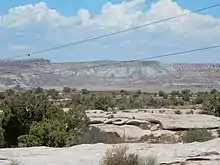
Though many of the Morrison Formation fossils are fragmentary, they are sufficient to provide a good picture of the flora and fauna in the Morrison Basin during the Kimmeridgian. Overall, the climate was dry, similar to a savanna but, since there were no angiosperms (grasses, flowers, and some trees), the flora was quite different. Conifers, the dominant plants of the time, were to be found with ginkgos, cycads, tree ferns, and horsetail rushes. Much of the fossilized vegetation was riparian, living along the river flood plains. Along the rivers, there were fish, frogs, salamanders, lizards, crocodiles, turtles, pterosaurs, crayfish, clams, and mammaliforms.
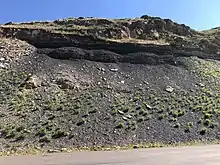
The dinosaurs were most likely riparian, as well.[6] Hundreds of dinosaur fossils have been discovered, such as Allosaurus, Ceratosaurus, Torvosaurus, Saurophaganax, Camptosaurus, Ornitholestes, several stegosaurs comprising at least two species of Stegosaurus and the slightly older Hesperosaurus, and the early ankylosaurs, Mymoorapelta and Gargoyleosaurus, most notably a very broad range of sauropods (the giants of the Mesozoic era).[29] Since at least some of these species are known to have nested in the area (Camptosaurus embryoes have been discovered), there are indications that it was a good environment for dinosaurs and not just home to migratory, seasonal populations. However, the large body mass of the sauropods has been interpreted as an adaptation to migration in times of drought.[6]
Sauropods that have been discovered include Diplodocus (most famously, the first nearly complete specimen of D. carnegii, which is now exhibited at the Carnegie Museum of Natural History, in Pittsburgh, Pennsylvania), Camarasaurus (the most commonly found sauropod), Brachiosaurus, Apatosaurus, Brontosaurus, Barosaurus, the uncommon Haplocanthosaurus and Supersaurus. The very diversity of the sauropods has raised some questions about how they could all co-exist. While their body shapes are very similar (long neck, long tail, huge elephant-like body), they are assumed to have had very different feeding strategies, in order for all to have existed in the same time frame and similar environment.
Sites and quarries
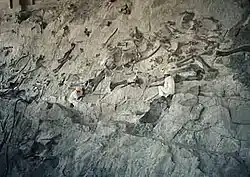
Locations where significant Morrison Formation fossil discoveries have been made include:
Colorado
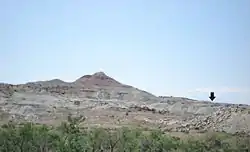
- Garden Park, Colorado: One of the three major sites excavated by the paleontologists Othniel Charles Marsh and Edward Drinker Cope during the Bone Wars in 1877, though most of the specimens were too incomplete to classify (nomina dubia) during the 1877-78 field seasons. The first nearly complete skeletons of Stegosaurus, Ceratosaurus, and Allosaurus were discovered at the site, including the type specimens of the former two and the proposed neotype of Allosaurus fragilis, in the 1883-1886 Yale field seasons.[30] In 1992, a specimen of Stegosaurus stenops was discovered with its armor still in place, which confirmed that the dinosaur had two rows of plates on its back.
- Dry Mesa Quarry, Colorado: A wide variety of fauna, as well as the most diverse set of dinosaurs from any Morrison Formation quarry. The first dig was in 1972, by researchers from Brigham Young University. Unique specimens include the longest dinosaur known, Supersaurus, the chimeric Ultrasauros, and the largest carnivore on the continent, Torvosaurus.
- Fruita Paleontological Resource Area: Badlands sites located south of Fruita, were actively worked by George Callison from California State University and the Los Angeles County Museum of Natural History. Numerous specimens of mammals, lizards, and crocodiles were found. Most recently, Fruitafossor windscheffelia and the new dinosaur Fruitadens were described from the area.
- Purgatoire River track site, Otero County.
Utah
- Cleveland-Lloyd Dinosaur Quarry, Utah: First excavated by geologists from the University of Utah in the late 1920s. William Lee Stokes led an expedition from Princeton in 1939. During the Jurassic, the quarry was a mudhole where several enormous sauropods got stuck and apparently caused a feeding frenzy that lured and trapped many carnivorous dinosaurs. Most of the allosaurs are from this site, as well as the unique Stokesosaurus and Marshosaurus.
- Dinosaur National Monument, Utah: First excavated by Earl Douglas working for the Carnegie Museum in 1909 with the purpose of finding sauropods from the Morrison Formation for public display. Monument also has fossilized dinosaurs from the Cedar Mountain Formation.
- Hanksville-Burpee Quarry, Hanksville
Wyoming
- Bone Cabin Quarry, Wyoming
- Como Bluff, Wyoming: One of the most renowned fossil sites in North America. It was first worked by Cope and particularly Marsh in 1877 and has been the source of many different sauropods and non-dinosaur species. The Cloverly Formation from the Cretaceous and some Triassic strata are also exposed at this location.
- The Wyoming Dinosaur Center, Thermopolis
- Ten Sleep, including Dana Quarry from where at least 12 sauropods and theropods are recovered.[31]
Economic geology
The Morrison Formation contains uranium deposits, including the Jackpile uranium body discovered near Grants, New Mexico in 1951.[12] The ore deposits in the rich Grants mineral belt are concentrated in sandstone beds of the Westwater Canyon Member and the Jackpile Member. Mines in this belt produced 340,000,000 pounds (150,000,000 kg) of U3O8 between 1948 and 2002. The uranium was precipitated by plant debris and humate that acted as reducing agents.[32]
See also
Citations
- ↑ "Morrison Formation" (PDF). CGKN. Retrieved 25 May 2013.
- ↑ Parrish, J.T.; Peterson, F.; Turner, C.E. (2004). "Jurassic "savannah"-plant taphonomy and climate of the Morrison Formation (Upper Jurassic, Western USA)" (PDF). Sedimentary Geology. 167 (3–4): 137–162. Bibcode:2004SedG..167..137P. doi:10.1016/j.sedgeo.2004.01.004.
- ↑ Trujillo, K.C.; Chamberlain, K.R.; Strickland, A. (2006). "Oxfordian U/Pb ages from SHRIMP analysis for the Upper Jurassic Morrison Formation of southeastern Wyoming with implications for biostratigraphic correlations". Geological Society of America Abstracts with Programs. 38 (6): 7.
- ↑ Bilbey, S.A. (1998). "Cleveland-Lloyd Dinosaur Quarry - age, stratigraphy and depositional environments". In Carpenter, K.; Chure, D.; Kirkland, J.I. (eds.). The Morrison Formation: An Interdisciplinary Study. Modern Geology. Vol. 22. Taylor and Francis Group. pp. 87–120. ISSN 0026-7775.
- ↑ Mateus, O. 2006. Late Jurassic dinosaurs from the Morrison Formation, the Lourinhã and Alcobaça Formations (Portugal), and the Tendaguru Beds (Tanzania): a comparison. in Foster, J.R. and Lucas, S. G. R.M., eds., 2006, Paleontology and Geology of the Upper Jurassic Morrison Formation. New Mexico Museum of Natural History and Science Bulletin 36: 223-231.
- 1 2 3 Turner, Christine E.; Peterson, Fred (May 2004). "Reconstruction of the Upper Jurassic Morrison Formation extinct ecosystem—a synthesis" (PDF). Sedimentary Geology. 167 (3–4): 309–355. Bibcode:2004SedG..167..309T. doi:10.1016/j.sedgeo.2004.01.009.
- ↑ "Geologic Unit: Morrison". USGS Geolex. Retrieved December 30, 2020.
- ↑ "Geologic Unit: Windy Hill". USGS Geolex. Retrieved December 30, 2020.
- ↑ Condon, S.M. "Stratigraphic Sections of the Middle Jurassic Wanakah Formation, Cow Springs Sandstone, and adjacent rocks, from Bluff, Utah, to Lupton, Arizona: U.S. Geologic Survey Oil and Gas Investigation Chart, OC-131". USGS Geolex. U.S. Geological Survey. Retrieved December 31, 2020.
- ↑ Bell, Thomas, "Deposition and Diagenesis of the Brushy Basin Member and the Upper Part of the Westwater Canyon Member of the Morrison Formation, San Juan Basin, New Mexico," in A Basin Analysis Case Study: The Morrison Grants Uranium Region New Mexico, edited by Neil S. Fishermen, Elmer S. Santos, and Christine E. Turner-Peterson, American Association of Petroleum Geolgists, Tulsa, 1986.
- ↑ Peterson, Fred (1988). "Revisions to Stratigraphic Nomenclature of Jurassic and Cretaceous Rocks of the Colorado Plateau" (PDF). U.S. Geological Survey Bulletin. 1633 (B): 13-56. Retrieved December 31, 2020.
- 1 2 Owen, Donald E.; Walters, Lester J. Jr.; Beck, Ronald G. (August 1984). "The Jackpile Sandstone Member of the Morrison Formation in west-central New Mexicoby Donald E. jwen, Consulting Geologist, Tulsa, 0K 74152, and Lester J.Walters, Jr. and Ronald G. Beck, ARCO Oil and Gas Co., Dallas, IX75221 a formal definiti" (PDF). New Mexico Geology. 6 (3). Retrieved 4 June 2020.
- ↑ Dickinson, William R.; Gehrels, George E. (2010). "Implications of U-Pb ages of detrital zircons in Mesozoic strata of the Four Corners region for provenance relations in space and time" (PDF). New Mexico Geological Society Field Conference Series. 61: 135–146. Retrieved 27 October 2020.
- ↑ Cather, Steven M. (2020). "Jurassic stratigraphic nomenclature for northwestern New Mexico" (PDF). New Mexico Geological Society Special Publication. 14: 145–151. Retrieved 31 October 2020.
- ↑ Carpenter, Kenneth; Lindsey, Eugene (2019-01-31). "Redefining the Upper Jurassic Morrison Formation in Garden Park National Natural Landmark and vicinity, eastern Colorado". Geology of the Intermountain West. 6: 1–30. doi:10.31711/giw.v6.pp1-30. ISSN 2380-7601.
- ↑ Condon, S.M.; Huffman, A.C. (1988). "Revisions in nomenclature of the Middle Jurassic Wanakah Formation, Northwest New Mexico and northeast Arizona". U.S. Geological Survey Bulletin. 1633 (A): 1-12. Retrieved 8 February 2021.
- 1 2 3 Allan R. Kirk; Steven M. Condon (1986). "Structural Control of Sedimentation Patterns and the Distribution of Uranium Deposits in the Westwater Canyon Member of the Morrison Formation, Northwestern New Mexico--A Subsurface Study". In Turner-Peterson, C.E.; Santos, Elmer S.; Fishman, Neil S. (eds.). Basin Analysis Case Study: The Morrison Formation, Grants Uranium Region, New Mexico. Tulsa: The American Association of Petroleum Geologists. p. 110-111.
- ↑ Peterson, Fred; Turner-Peterson, C.E. (1987). "The Morrison Formation of the Colorado Plateau: recent advances in sedimentology, stratigraphy, and paleotectonics". Hunter. 2 (1): 1-18. Retrieved 8 February 2021.
- 1 2 O'Sullivan, R.B. (1984). "The base of the Upper Jurassic Morrison Formation in east-central Utah". U.S. Geological Survey Bulletin. 1561: 17. Retrieved 8 February 2021.
- ↑ Peterson, Fred (1988). "Stratigraphy and Nomenclature of Middle and Upper Jurassic rocks, western Colorado Plateau, Utah and Arizona". U.S. Geological Survey Bulletin. 1633 (B): 13-56. Retrieved 9 February 2021.
- 1 2 Mapel, W.J.; Chisholm, W.A. (1962). "Nonopaque heavy minerals in sandstone of Jurassic and Cretaceous age in the Black Hills, Wyoming and South Dakota". U.S. Geological Survey Bulletin. 1161 (C): 1-59.
- ↑ Szigeti, G.J; Fox, J.E. (1979). "Unkpapa Sandstone (Jurassic), Black Hills, South Dakota; an eolian facies of the Morrison Formation". In Ethridge, F.G.; Flores, R.M. (eds.). Recent and Ancient non marine depositional environments: models for exploration. Casper, WY: Society of Economic Paleontologists and Mineralogists Special Publication. p. 331-349.
- ↑ Christine E. Turner-Peterson (1986). "Fluvial Sedimentology of a Major Uranium-Bearing Sandstone-- A Study of the Westwater Canyon Member of the Morrison Formation, San Juan Basin, New Mexico". In Turner-Peterson, C.E.; Santos, Elmer S.; Fishman, Neil S. (eds.). Basin Analysis Case Study: The Morrison Formation, Grants Uranium Region, New Mexico. Tulsa: The American Association of Petroleum Geologists. p. 110-111.
- ↑ Fred Peterson. "Sand dunes, sabkhas, streams, and shallow seas: Jurassic paleogeography in the southern part of the Western Interior Basin". In Caputo, M.V.; Peterson, J.A.; Franczyk, K.J. (eds.). Mesozoic Systems of the Rocky Mountain Region, USA. Society of Economic Paleontologists and Mineralogists, Rocky Mountain Section. p. 233-272.
- ↑ Pipiringos, G.N. (1968). "Correlation and Nomenclature of some Triassic and Jurassic Rocks in south-central Wyoming". U.S. Geological Survey Professional Paper. 594 (D): 1-26. Retrieved 8 February 2021.
- ↑ Daniel, J.A.; Bartholomew, M.J.; Murray, R.C. (1992). "Geological Characteristics of the Stockett Bed Coal in the Central Great Falls Coal Field, Montana". Montana Bureau of Mines and Geology Special Publication. 102: 145-157.
- ↑ Smith, C.T. (1954). "Geology of the Thoreau quadrangle, McKinley and Valencia Counties, New Mexico". New Mexico Bureau of Mines and Mineral Resources. 31.
- ↑ Robertson, J.F. (1990). "Geologic map of the Thoreau quadrangle, McKinley County, New Mexico". U.S. Geological Survey.
- ↑ Dodson, Peter; Behrensmeyer, A. K.; Bakker, Robert T.; McIntosh, John S. (1980). "Taphonomy and Paleoecology of the Dinosaur Beds of the Jurassic Morrison Formation". Paleobiology. 6 (2): 208–232. doi:10.1017/s009483730000676x. ISSN 0094-8373. S2CID 130686856.
- ↑ Evanoff, E., & Carpenter, K. (1998). History, sedimentology, and taphonomy of felch quarry 1 and associated sandbodies, Morrison Formation, Garden Park, Colorado. Modern Geology, 22, 423-170.
- ↑ Saleiro, A., & Mateus O. (2017). Upper Jurassic bonebeds around Ten Sleep, Wyoming, USA: overview and stratigraphy. Abstract book of the XV Encuentro de Jóvenes Investigadores en Paleontología/XV Encontro de Jovens Investigadores em Paleontologia, Lisboa, 428 pp.. 357-361.
- ↑ Wilton, Ted; Chavez, William X. Jr.; Caldwell, Samantha (2020). "Sandstone-hosted uranium deposits at the Cebolleta Land Grant, Cibola County, New Mexico" (PDF). New Mexico Geological Society Special Publication. 14: 67–75. Retrieved 27 October 2020.
Further reading
- Foster, J. 2007. Jurassic West: The Dinosaurs of the Morrison Formation and Their World. Indiana University Press. 389pp.
- Foster, J.R. 2003. Paleoecological Analysis of the Vertebrate Fauna of the Morrison Formation (Upper Jurassic), Rocky Mountain Region, U.S.A. Albuquerque, New Mexico: New Mexico Museum of Natural History and Science. Bulletin 23.
- Jenkins, J.T. and J.L. Jenkins. 1993. Colorado's Dinosaurs. Denver, Colorado: Colorado Geologic Survey. Special Publication 35.
- Mateus, O. 2006. Late Jurassic dinosaurs from the Morrison Formation, the Lourinhã and Alcobaça Formations (Portugal), and the Tendaguru Beds (Tanzania): a comparison. in Foster, J.R. and Lucas, S. G. R.M., eds., 2006, Paleontology and Geology of the Upper Jurassic Morrison Formation. New Mexico Museum of Natural History and Science Bulletin 36: 223-231.
External links
- Morrison Natural History Museum home page.
- Dinosaurs and the History of Life, Columbia University lecture on the Morrison Formation.
- Geology of the (Dinosaur National Monument) Quarry, from the National Park Service.
- Spatial distribution of Morrison in Macrostrat.
- Paleobiology Database: Dalton Well Dinosaur Track Site (Morrison Formation): Late/Upper Jurassic, Utah
- Paleobiology Database: Black Ridge Dinosaur Track Site (Morrison Formation): Late/Upper Jurassic, Colorado
- Catalogue of Morrison mammals (bottom of the page)
- NPS.gov: "About the Morrison Formation in Dinosaur National Monument
- Britannica.com: Morrison Formation geology